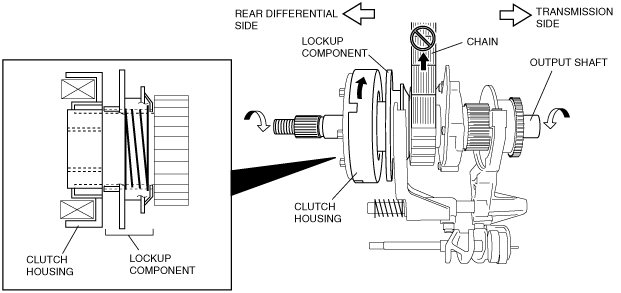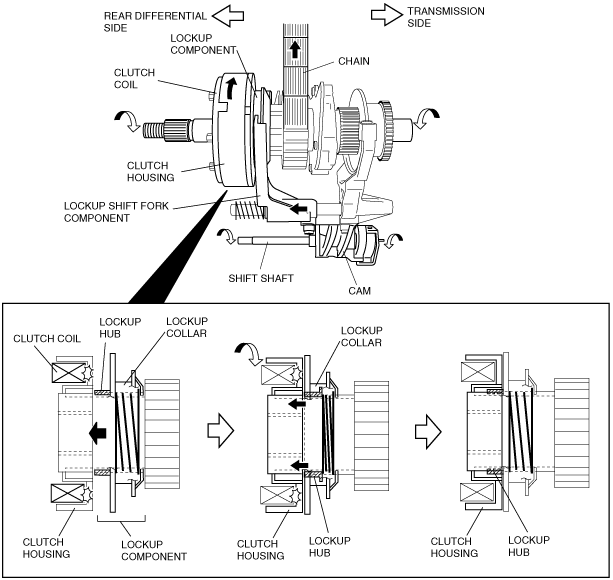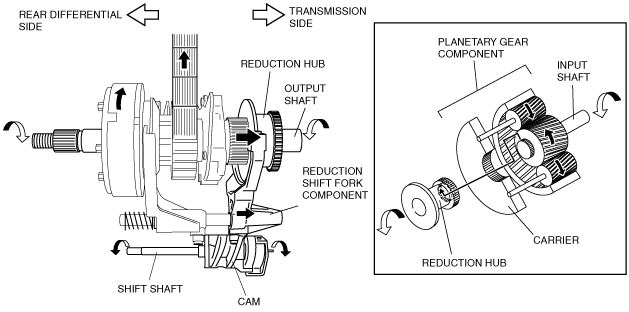TRANSFER CASE POWER FLOW [5R55S]
id0316c1100600
Shifting From 4x2 HIGH to 4x4 HIGH
• During 4x2 driving, drive force from the transmission is transmitted from the input shaft to the output shaft through the reduction hub, and the drive force from the output shaft is transmitted to the rear differential
Shifting between 4x2 and 4x4 is performed using the lockup component operation. During 4x2 driving, drive force is not transmitted to the chain because the lockup component does not contact the clutch housing, therefore, the drive force is not transmitted to the front differential.
• When the 4x4 switch is switched to the 4H position during 4x2 driving, the motor rotates from the 2H to 4H position. Due to the motor rotation, the cam rotates via the shift shaft. When the cam rotates, the lockup shift fork component slides to the clutch housing side. In conjunction with this operation, the clutch coil is energized and magnetic force is generated, and the lockup shift fork component is pulled toward the clutch housing. In the lockup shift fork component operation, the lockup hub contacts the clutch housing first, then the lockup collar slides to the lockup housing side. At this time, if the lockup hub is not engaged with the clutch housing spline, the lock up hub is pressed into the lockup collar. If the clutch housing rotates in this condition, such as when the vehicle is being driven, the lockup hub engages with the clutch housing spline. The lockup shift fork component is engaged with the drive sprocket and the clutch housing is engaged with the
output shaft, therefore, drive force from the output shaft is transmitted to the lower output shaft via the chain. Due to this, drive force is transmitted to the front differential.
Shifting From 4x4 HIGH to 4x2 HIGH
• When the 4x4 switch is switched to the 2H position while in 4x4 HIGH, the motor rotates from the 4H to 2H position. Due to the motor rotation, the cam rotates via the shift shaft. The lockup shift fork component slides due to the cam rotation and spring force of the return spring, and separates from the clutch housing. At this time, the clutch coil is not energized.When the lockup shift fork component separates from the clutch housing, drive force transmission to the lower output side is interrupted, and drive force is transmitted only to the rear differential.
Shifting From 4x4 HIGH to 4x4 LOW
• When the 4x4 switch is switched to the 4L position while in 4x4 HIGH, the motor rotates from the 4H to 4L position. Due to the motor rotation, the cam rotates via the shift shaft. When the cam rotates the reduction shift fork component, which is fitted into the cam groove, slides, and the reduction hub engages with the spline which is inside the carrier of the planetary gear component. If the drive force is transmitted to the input shaft in this condition, the output speed is reduced due to the planetary gear operation, and the rotational torque increases.This drive force is transmitted to the front and rear differentials.
Shifting From 4x4 LOW to 4x4 HIGH
• When the 4x4 switch is switched to the 4H position while in 4x4 LOW, the motor rotates from the 4L to 4H position. Due to the motor rotation, the cam rotates via the shift shaft. When the cam rotates the reduction shift fork component, which is fitted into the cam groove, slides, and the reduction hub engages with the input shaft spline. Due to this, the drive force from the input shaft is transmitted to the output shaft without being input to the planetary gear, and then it is transmitted to the front and rear differential with the output speed and rotational torque remaining unchanged.




